Domestic Violence in Australia: Analysis of Causes and Recommendations
VerifiedAdded on 2023/06/08
|6
|1310
|376
Report
AI Summary
This report provides an in-depth analysis of domestic violence in Australia, defining it according to the Family Law Act of 1975. The report examines the causes and effects of domestic violence, particularly focusing on women and children, and draws on statistical data from various Australian regions between 2014 and 2016. The report explores the correlation between alcohol and substance abuse, socio-economic factors, and homelessness with the incidence of domestic violence. It also highlights government initiatives, such as the Partnerships and National Indigenous Violence grants programs, designed to address the issue. The report concludes with recommendations for intervention, including advocating for leave policies for victims, establishing rehabilitation centers, providing affordable housing, increasing funding for support services, enforcing strict laws, and introducing educational subjects on morals. The report emphasizes the need for an annual assessment of progress to combat domestic violence.
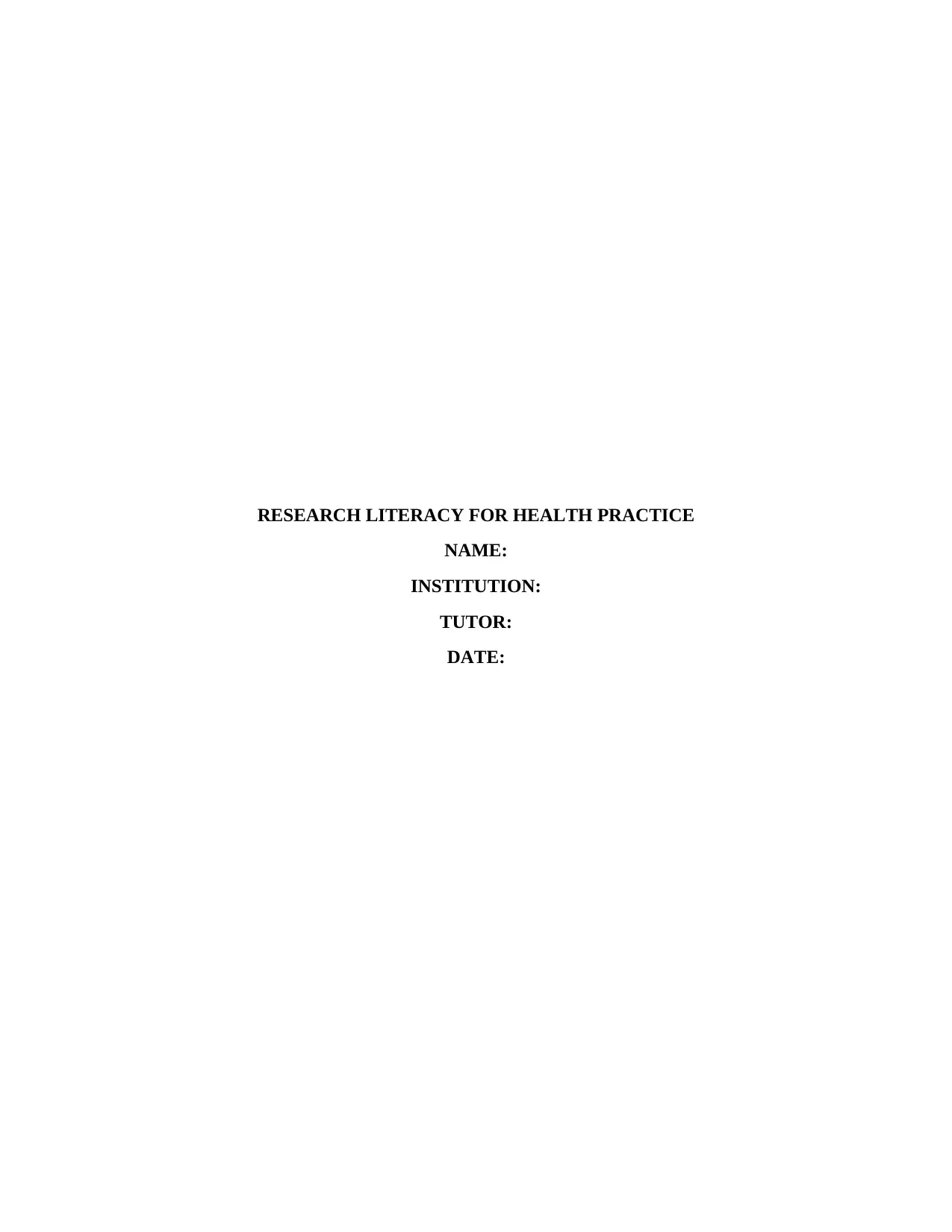
RESEARCH LITERACY FOR HEALTH PRACTICE
NAME:
INSTITUTION:
TUTOR:
DATE:
NAME:
INSTITUTION:
TUTOR:
DATE:
Paraphrase This Document
Need a fresh take? Get an instant paraphrase of this document with our AI Paraphraser
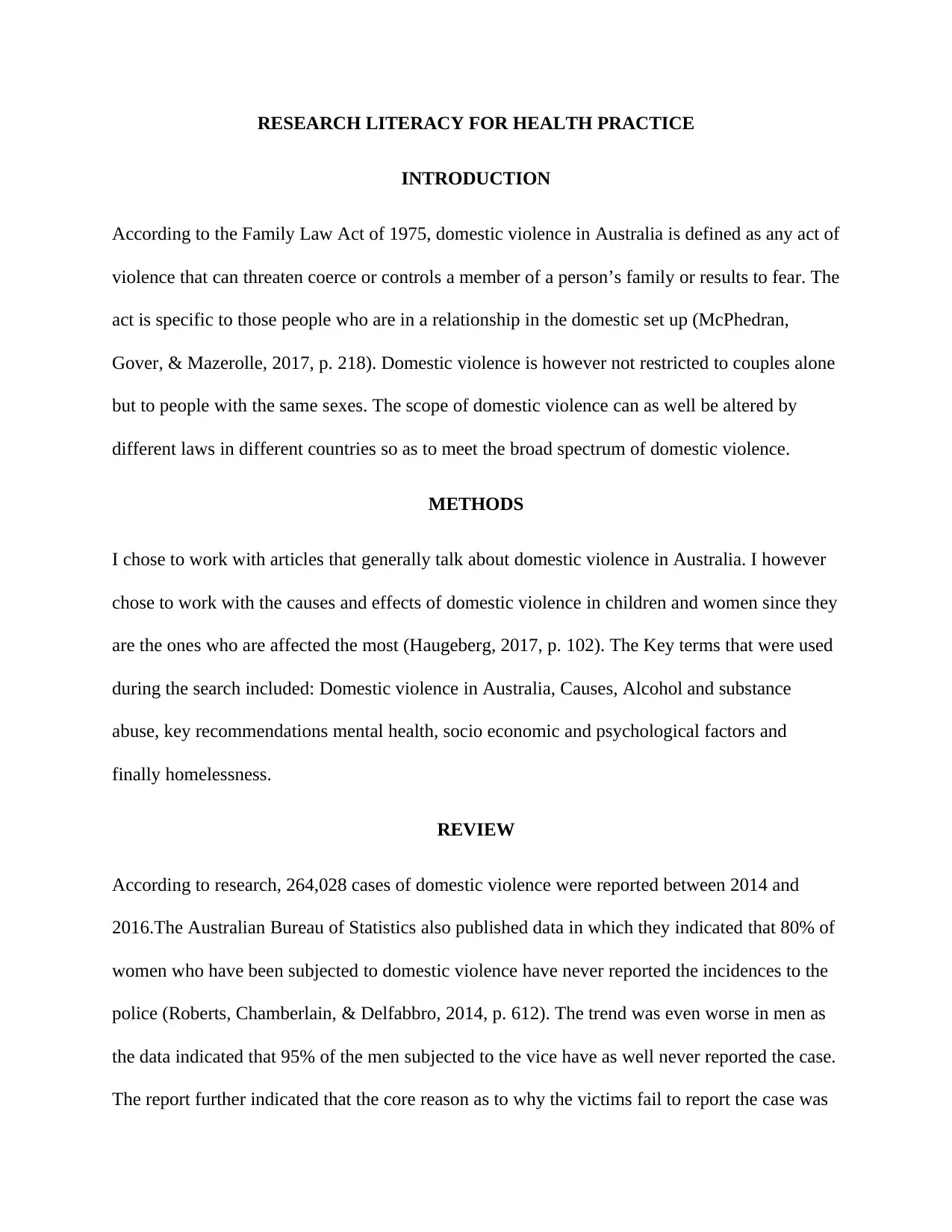
RESEARCH LITERACY FOR HEALTH PRACTICE
INTRODUCTION
According to the Family Law Act of 1975, domestic violence in Australia is defined as any act of
violence that can threaten coerce or controls a member of a person’s family or results to fear. The
act is specific to those people who are in a relationship in the domestic set up (McPhedran,
Gover, & Mazerolle, 2017, p. 218). Domestic violence is however not restricted to couples alone
but to people with the same sexes. The scope of domestic violence can as well be altered by
different laws in different countries so as to meet the broad spectrum of domestic violence.
METHODS
I chose to work with articles that generally talk about domestic violence in Australia. I however
chose to work with the causes and effects of domestic violence in children and women since they
are the ones who are affected the most (Haugeberg, 2017, p. 102). The Key terms that were used
during the search included: Domestic violence in Australia, Causes, Alcohol and substance
abuse, key recommendations mental health, socio economic and psychological factors and
finally homelessness.
REVIEW
According to research, 264,028 cases of domestic violence were reported between 2014 and
2016.The Australian Bureau of Statistics also published data in which they indicated that 80% of
women who have been subjected to domestic violence have never reported the incidences to the
police (Roberts, Chamberlain, & Delfabbro, 2014, p. 612). The trend was even worse in men as
the data indicated that 95% of the men subjected to the vice have as well never reported the case.
The report further indicated that the core reason as to why the victims fail to report the case was
INTRODUCTION
According to the Family Law Act of 1975, domestic violence in Australia is defined as any act of
violence that can threaten coerce or controls a member of a person’s family or results to fear. The
act is specific to those people who are in a relationship in the domestic set up (McPhedran,
Gover, & Mazerolle, 2017, p. 218). Domestic violence is however not restricted to couples alone
but to people with the same sexes. The scope of domestic violence can as well be altered by
different laws in different countries so as to meet the broad spectrum of domestic violence.
METHODS
I chose to work with articles that generally talk about domestic violence in Australia. I however
chose to work with the causes and effects of domestic violence in children and women since they
are the ones who are affected the most (Haugeberg, 2017, p. 102). The Key terms that were used
during the search included: Domestic violence in Australia, Causes, Alcohol and substance
abuse, key recommendations mental health, socio economic and psychological factors and
finally homelessness.
REVIEW
According to research, 264,028 cases of domestic violence were reported between 2014 and
2016.The Australian Bureau of Statistics also published data in which they indicated that 80% of
women who have been subjected to domestic violence have never reported the incidences to the
police (Roberts, Chamberlain, & Delfabbro, 2014, p. 612). The trend was even worse in men as
the data indicated that 95% of the men subjected to the vice have as well never reported the case.
The report further indicated that the core reason as to why the victims fail to report the case was
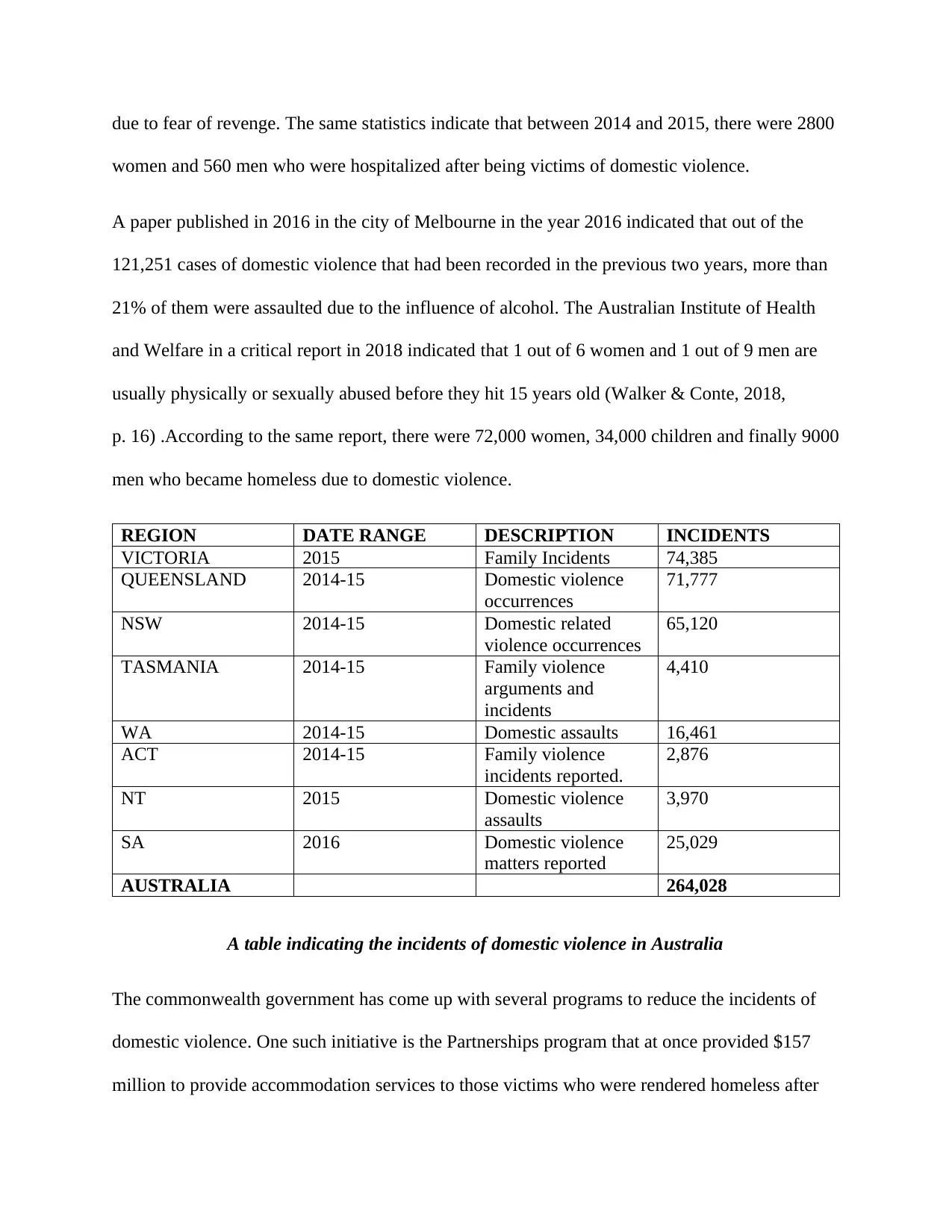
due to fear of revenge. The same statistics indicate that between 2014 and 2015, there were 2800
women and 560 men who were hospitalized after being victims of domestic violence.
A paper published in 2016 in the city of Melbourne in the year 2016 indicated that out of the
121,251 cases of domestic violence that had been recorded in the previous two years, more than
21% of them were assaulted due to the influence of alcohol. The Australian Institute of Health
and Welfare in a critical report in 2018 indicated that 1 out of 6 women and 1 out of 9 men are
usually physically or sexually abused before they hit 15 years old (Walker & Conte, 2018,
p. 16) .According to the same report, there were 72,000 women, 34,000 children and finally 9000
men who became homeless due to domestic violence.
REGION DATE RANGE DESCRIPTION INCIDENTS
VICTORIA 2015 Family Incidents 74,385
QUEENSLAND 2014-15 Domestic violence
occurrences
71,777
NSW 2014-15 Domestic related
violence occurrences
65,120
TASMANIA 2014-15 Family violence
arguments and
incidents
4,410
WA 2014-15 Domestic assaults 16,461
ACT 2014-15 Family violence
incidents reported.
2,876
NT 2015 Domestic violence
assaults
3,970
SA 2016 Domestic violence
matters reported
25,029
AUSTRALIA 264,028
A table indicating the incidents of domestic violence in Australia
The commonwealth government has come up with several programs to reduce the incidents of
domestic violence. One such initiative is the Partnerships program that at once provided $157
million to provide accommodation services to those victims who were rendered homeless after
women and 560 men who were hospitalized after being victims of domestic violence.
A paper published in 2016 in the city of Melbourne in the year 2016 indicated that out of the
121,251 cases of domestic violence that had been recorded in the previous two years, more than
21% of them were assaulted due to the influence of alcohol. The Australian Institute of Health
and Welfare in a critical report in 2018 indicated that 1 out of 6 women and 1 out of 9 men are
usually physically or sexually abused before they hit 15 years old (Walker & Conte, 2018,
p. 16) .According to the same report, there were 72,000 women, 34,000 children and finally 9000
men who became homeless due to domestic violence.
REGION DATE RANGE DESCRIPTION INCIDENTS
VICTORIA 2015 Family Incidents 74,385
QUEENSLAND 2014-15 Domestic violence
occurrences
71,777
NSW 2014-15 Domestic related
violence occurrences
65,120
TASMANIA 2014-15 Family violence
arguments and
incidents
4,410
WA 2014-15 Domestic assaults 16,461
ACT 2014-15 Family violence
incidents reported.
2,876
NT 2015 Domestic violence
assaults
3,970
SA 2016 Domestic violence
matters reported
25,029
AUSTRALIA 264,028
A table indicating the incidents of domestic violence in Australia
The commonwealth government has come up with several programs to reduce the incidents of
domestic violence. One such initiative is the Partnerships program that at once provided $157
million to provide accommodation services to those victims who were rendered homeless after
⊘ This is a preview!⊘
Do you want full access?
Subscribe today to unlock all pages.

Trusted by 1+ million students worldwide
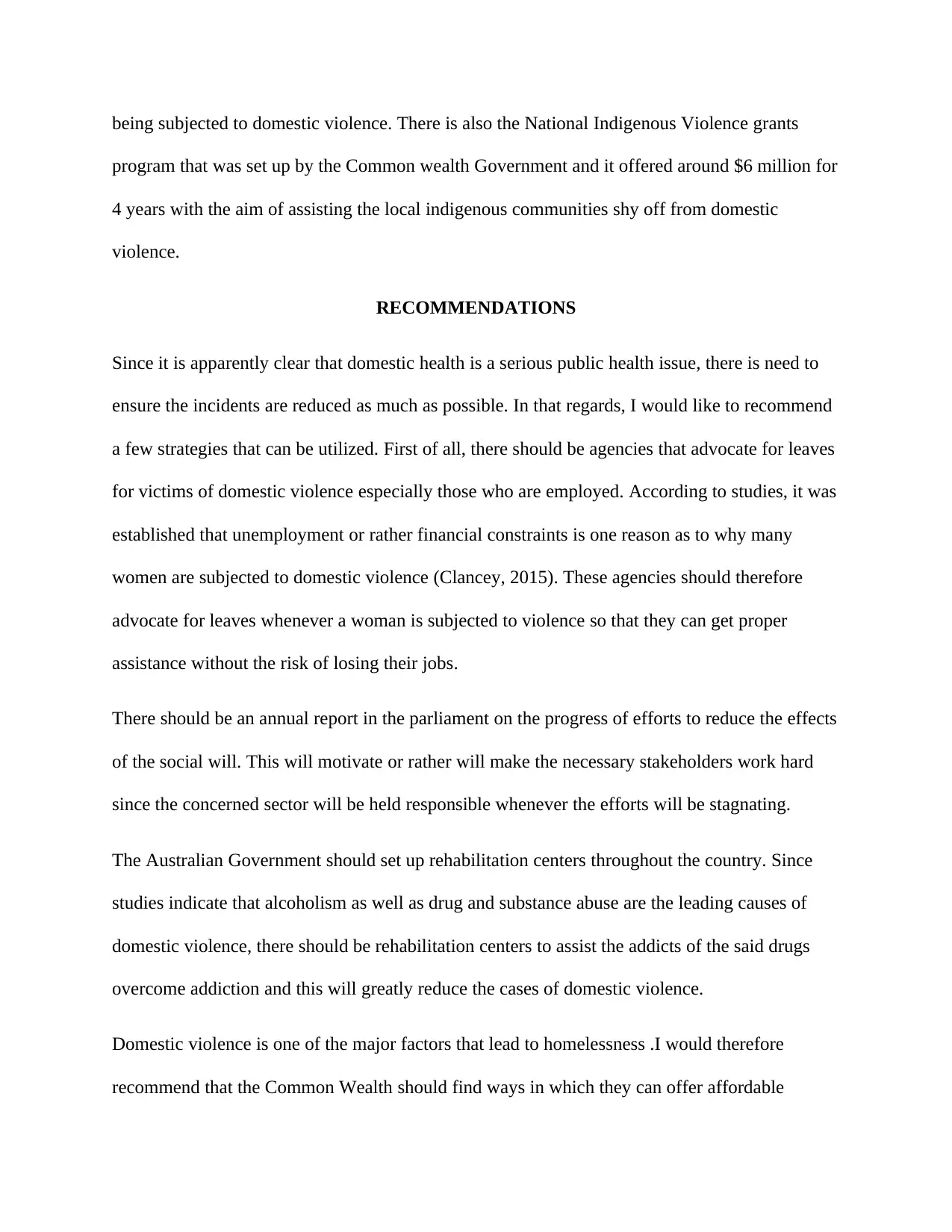
being subjected to domestic violence. There is also the National Indigenous Violence grants
program that was set up by the Common wealth Government and it offered around $6 million for
4 years with the aim of assisting the local indigenous communities shy off from domestic
violence.
RECOMMENDATIONS
Since it is apparently clear that domestic health is a serious public health issue, there is need to
ensure the incidents are reduced as much as possible. In that regards, I would like to recommend
a few strategies that can be utilized. First of all, there should be agencies that advocate for leaves
for victims of domestic violence especially those who are employed. According to studies, it was
established that unemployment or rather financial constraints is one reason as to why many
women are subjected to domestic violence (Clancey, 2015). These agencies should therefore
advocate for leaves whenever a woman is subjected to violence so that they can get proper
assistance without the risk of losing their jobs.
There should be an annual report in the parliament on the progress of efforts to reduce the effects
of the social will. This will motivate or rather will make the necessary stakeholders work hard
since the concerned sector will be held responsible whenever the efforts will be stagnating.
The Australian Government should set up rehabilitation centers throughout the country. Since
studies indicate that alcoholism as well as drug and substance abuse are the leading causes of
domestic violence, there should be rehabilitation centers to assist the addicts of the said drugs
overcome addiction and this will greatly reduce the cases of domestic violence.
Domestic violence is one of the major factors that lead to homelessness .I would therefore
recommend that the Common Wealth should find ways in which they can offer affordable
program that was set up by the Common wealth Government and it offered around $6 million for
4 years with the aim of assisting the local indigenous communities shy off from domestic
violence.
RECOMMENDATIONS
Since it is apparently clear that domestic health is a serious public health issue, there is need to
ensure the incidents are reduced as much as possible. In that regards, I would like to recommend
a few strategies that can be utilized. First of all, there should be agencies that advocate for leaves
for victims of domestic violence especially those who are employed. According to studies, it was
established that unemployment or rather financial constraints is one reason as to why many
women are subjected to domestic violence (Clancey, 2015). These agencies should therefore
advocate for leaves whenever a woman is subjected to violence so that they can get proper
assistance without the risk of losing their jobs.
There should be an annual report in the parliament on the progress of efforts to reduce the effects
of the social will. This will motivate or rather will make the necessary stakeholders work hard
since the concerned sector will be held responsible whenever the efforts will be stagnating.
The Australian Government should set up rehabilitation centers throughout the country. Since
studies indicate that alcoholism as well as drug and substance abuse are the leading causes of
domestic violence, there should be rehabilitation centers to assist the addicts of the said drugs
overcome addiction and this will greatly reduce the cases of domestic violence.
Domestic violence is one of the major factors that lead to homelessness .I would therefore
recommend that the Common Wealth should find ways in which they can offer affordable
Paraphrase This Document
Need a fresh take? Get an instant paraphrase of this document with our AI Paraphraser
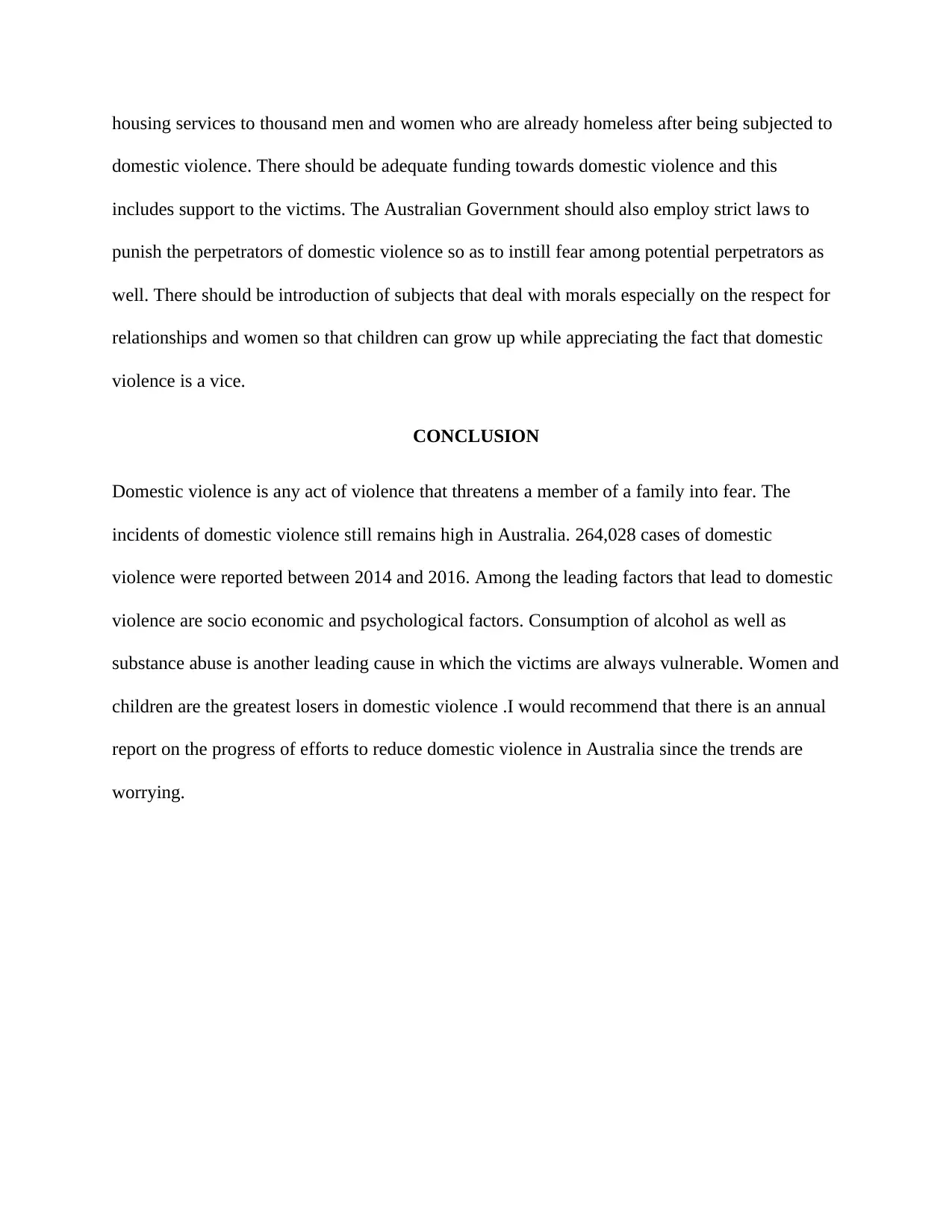
housing services to thousand men and women who are already homeless after being subjected to
domestic violence. There should be adequate funding towards domestic violence and this
includes support to the victims. The Australian Government should also employ strict laws to
punish the perpetrators of domestic violence so as to instill fear among potential perpetrators as
well. There should be introduction of subjects that deal with morals especially on the respect for
relationships and women so that children can grow up while appreciating the fact that domestic
violence is a vice.
CONCLUSION
Domestic violence is any act of violence that threatens a member of a family into fear. The
incidents of domestic violence still remains high in Australia. 264,028 cases of domestic
violence were reported between 2014 and 2016. Among the leading factors that lead to domestic
violence are socio economic and psychological factors. Consumption of alcohol as well as
substance abuse is another leading cause in which the victims are always vulnerable. Women and
children are the greatest losers in domestic violence .I would recommend that there is an annual
report on the progress of efforts to reduce domestic violence in Australia since the trends are
worrying.
domestic violence. There should be adequate funding towards domestic violence and this
includes support to the victims. The Australian Government should also employ strict laws to
punish the perpetrators of domestic violence so as to instill fear among potential perpetrators as
well. There should be introduction of subjects that deal with morals especially on the respect for
relationships and women so that children can grow up while appreciating the fact that domestic
violence is a vice.
CONCLUSION
Domestic violence is any act of violence that threatens a member of a family into fear. The
incidents of domestic violence still remains high in Australia. 264,028 cases of domestic
violence were reported between 2014 and 2016. Among the leading factors that lead to domestic
violence are socio economic and psychological factors. Consumption of alcohol as well as
substance abuse is another leading cause in which the victims are always vulnerable. Women and
children are the greatest losers in domestic violence .I would recommend that there is an annual
report on the progress of efforts to reduce domestic violence in Australia since the trends are
worrying.
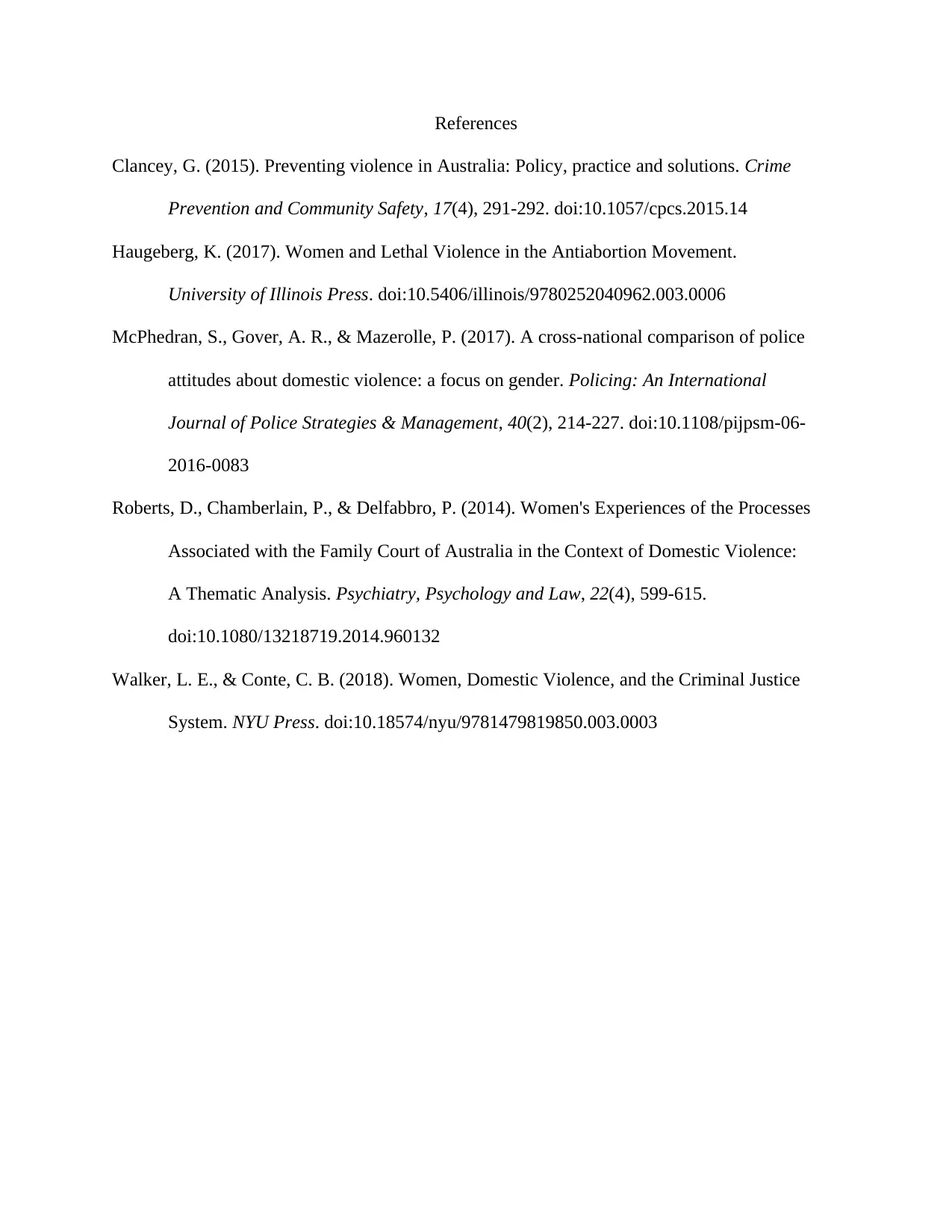
References
Clancey, G. (2015). Preventing violence in Australia: Policy, practice and solutions. Crime
Prevention and Community Safety, 17(4), 291-292. doi:10.1057/cpcs.2015.14
Haugeberg, K. (2017). Women and Lethal Violence in the Antiabortion Movement.
University of Illinois Press. doi:10.5406/illinois/9780252040962.003.0006
McPhedran, S., Gover, A. R., & Mazerolle, P. (2017). A cross-national comparison of police
attitudes about domestic violence: a focus on gender. Policing: An International
Journal of Police Strategies & Management, 40(2), 214-227. doi:10.1108/pijpsm-06-
2016-0083
Roberts, D., Chamberlain, P., & Delfabbro, P. (2014). Women's Experiences of the Processes
Associated with the Family Court of Australia in the Context of Domestic Violence:
A Thematic Analysis. Psychiatry, Psychology and Law, 22(4), 599-615.
doi:10.1080/13218719.2014.960132
Walker, L. E., & Conte, C. B. (2018). Women, Domestic Violence, and the Criminal Justice
System. NYU Press. doi:10.18574/nyu/9781479819850.003.0003
Clancey, G. (2015). Preventing violence in Australia: Policy, practice and solutions. Crime
Prevention and Community Safety, 17(4), 291-292. doi:10.1057/cpcs.2015.14
Haugeberg, K. (2017). Women and Lethal Violence in the Antiabortion Movement.
University of Illinois Press. doi:10.5406/illinois/9780252040962.003.0006
McPhedran, S., Gover, A. R., & Mazerolle, P. (2017). A cross-national comparison of police
attitudes about domestic violence: a focus on gender. Policing: An International
Journal of Police Strategies & Management, 40(2), 214-227. doi:10.1108/pijpsm-06-
2016-0083
Roberts, D., Chamberlain, P., & Delfabbro, P. (2014). Women's Experiences of the Processes
Associated with the Family Court of Australia in the Context of Domestic Violence:
A Thematic Analysis. Psychiatry, Psychology and Law, 22(4), 599-615.
doi:10.1080/13218719.2014.960132
Walker, L. E., & Conte, C. B. (2018). Women, Domestic Violence, and the Criminal Justice
System. NYU Press. doi:10.18574/nyu/9781479819850.003.0003
⊘ This is a preview!⊘
Do you want full access?
Subscribe today to unlock all pages.

Trusted by 1+ million students worldwide
1 out of 6
Related Documents
Your All-in-One AI-Powered Toolkit for Academic Success.
+13062052269
info@desklib.com
Available 24*7 on WhatsApp / Email
![[object Object]](/_next/static/media/star-bottom.7253800d.svg)
Unlock your academic potential
Copyright © 2020–2025 A2Z Services. All Rights Reserved. Developed and managed by ZUCOL.





